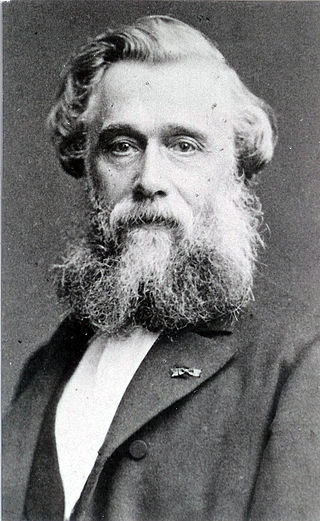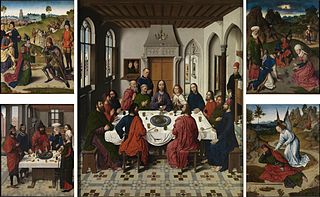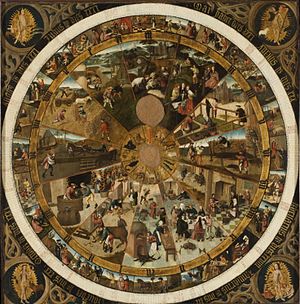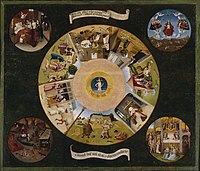
Gerard David was an Early Netherlandish painter and manuscript illuminator known for his brilliant use of color. Only a bare outline of his life survives, although some facts are known. He may have been the Meester gheraet van brugghe who became a master of the Antwerp guild in 1515. He was very successful in his lifetime and probably ran two workshops, in Antwerp and Bruges. Like many painters of his period, his reputation diminished in the 17th century until he was rediscovered in the 19th century.

Adriaen Isenbrandt or Adriaen Ysenbrandt was a painter in Bruges, in the final years of Early Netherlandish painting, and the first of the Dutch and Flemish Renaissance painting of the Northern Renaissance. Documentary evidence suggests he was a significant and successful artist of his period, even though no specific works by his hand are clearly documented. Art historians have conjectured that he operated a large workshop specializing in religious subjects and devotional paintings, which were executed in a conservative style in the tradition of the Early Netherlandish painting of the previous century. By his time, the new booming economy of Antwerp had made this the centre of painting in the Low Countries, but the previous centre of Bruges retained considerable prestige.

Petrus Christus was an Early Netherlandish painter active in Bruges from 1444, where, along with Hans Memling, he became the leading painter after the death of Jan van Eyck. He was influenced by van Eyck and Rogier van der Weyden and is noted for his innovations with linear perspective and a meticulous technique which seems derived from miniatures and manuscript illumination. Today, some 30 works are confidently attributed to him. The best known include the Portrait of a Carthusian (1446) and Portrait of a Young Girl ; both are highly innovative in the presentation of the figure against detailed, rather than flat, backgrounds.

The Seven Deadly Sins and the Four Last Things is a painting attributed to the Early Netherlandish artist Hieronymus Bosch or to a follower of his, completed around 1500 or later. Since 1898 its authenticity has been questioned several times. In 2015 the Bosch Research Conservation Project claimed it to be by a follower, but scholars at the Prado, where the painting is on display in a sealed case, dismissed this argument. The painting is oil on wooden panels and is presented in a series of circular images.

Dieric Bouts was an Early Netherlandish painter. Bouts may have studied under Rogier van der Weyden, and his work was influenced by van der Weyden and Jan van Eyck. He worked in Leuven from 1457 until his death in 1475.

Jean François Xavier Roffiaen was a Belgian landscape painter who specialised in painting Alpine landscapes.

The Crucifixion and Last Judgement diptych consists of two small painted panels attributed to the Early Netherlandish artist Jan van Eyck, with areas finished by unidentified followers or members of his workshop. This diptych is one of the early Northern Renaissance oil-on-panel masterpieces, renowned for its unusually complex and highly detailed iconography, and for the technical skill evident in its completion. It was executed in a miniature format; the panels are just 56.5 cm (22.2 in) high by 19.7 cm (7.8 in) wide. The diptych was probably commissioned for private devotion.

The Exposition des primitifs flamands à Bruges was an art exhibition of paintings by the so-called Flemish Primitives held in the Provinciaal Hof in Bruges between 15 June and 5 October 1902.

The St John Altarpiece is a large oil-on-oak hinged-triptych altarpiece completed around 1479 by the Early Netherlandish master painter Hans Memling. It was commissioned in the mid-1470s in Bruges for the Old St. John's Hospital (Sint-Janshospitaal) during the building of a new apse. It is signed and dated 1479 on the original frame – its date of installation – and is today still at the hospital in the Memling museum.

William Henry James Weale was a British art historian who lived and worked most of his life in Bruges and was one of the first to research the Early Netherlandish painting extensively. He was also a pioneer in the study of early bookbinding, and a staunch promoter of Gothic Revival architecture.

Jan Rombouts the Elder, Jan Rombouts (I) (c. 1480 in Leuven – 1535 in Leuven), was a Flemish Renaissance painter, glass painter, draftsman, printmaker and glass designer. The subjects of his work are stories from the Old and New Testament and the lives of Christian saints. He was active in Leuven where he introduced the Renaissance innovations of Bernard van Orley and the Antwerp school.

Josse van der Baren was a Flemish painter of history paintings and a draughtsman active in the Leuven area around the turn of the 17th century.

Pieter-Jozef Verhaghen was a Flemish painter of large-scale religious and mythological scenes. He is regarded as the last representative of the so-called Flemish School of painting. In particular, he is seen as continuing the artistic tradition of Flemish Baroque painting as exemplified by Rubens in the late 18th century and into the 19th century. He was highly regarded during his lifetime and enjoyed the patronage of eminent patrons and religious institutions. He was appointed first court painter to Empress Maria Theresa of Austria who also provided him a stipend to travel abroad to further his artistic studies.

The Mystic Marriage of St. Catherine is a c. 1480 oil-on-oak painting by the Early Netherlandish painter Hans Memling, now in the Metropolitan Museum of Art, New York. The Virgin Mary sits on a throne in a garden holding the Child Jesus in her lap. Mother and child are flanked by angels playing musical instruments, with St Catherine of Alexandria to the left opposite St Barbara on the right. The male figure standing slightly behind the celestial group presumably commissioned the painting as a devotional donor portrait.

The Annunciation is an oil painting by the Early Netherlandish painter Hans Memling. It depicts the Annunciation, the archangel Gabriel's announcement to the Virgin Mary that she would conceive and become the mother of Jesus, described in the Gospel of Luke. The painting was executed in the 1480s and was transferred to canvas from its original oak panel sometime after 1928; it is today held in the Robert Lehman collection of the Metropolitan Museum of Art in New York.

The City Hall of Bruges, West Flanders, Belgium, is a landmark building and the seat of that city. Built in a late-Gothic monumental style between 1376 and 1421, it is one of the oldest city halls in the former Burgundian Netherlands. It is located on Burg Square, the area of the former fortified castle in the centre of Bruges.

The Diptych of an elderly couple is a pair of bust-length wedding portraits by Hans Memling, which were formerly attached with pegs and were split some time before they were sold separately in 1894. One is in the collection of the Gemäldegalerie and the other is in the collection of the Louvre. When viewed side by side the landscape background joins up to form a whole.

Altarpiece of the Holy Sacrament or Triptych of the Last Supper is a 1464–1468 dated folding triptych with at least five panel paintings attributed to the Flemish painter Dieric Bouts, now reassembled and held at its location of origin in the eastern choir chapel of St. Peter's Church, Leuven, Belgium.

The Martyrdom of Saint Erasmus is a triptych panel painting by the Flemish painter Dieric Bouts in the collegiate church of Saint Peter's in Leuven, Belgium. It commemorates the martyrdom and death of a European Christian figure from the fourth century, Saint Erasmus. It shows the Emperor Diocletian as one of four observers in the background of the center panel, as well as Saints Jerome and Bernard of Clairvaux in the wings of the altarpiece. All nine figures appear to express an exceptional tranquility and calm, in a landscape setting that is contiguous across the three panels.






















